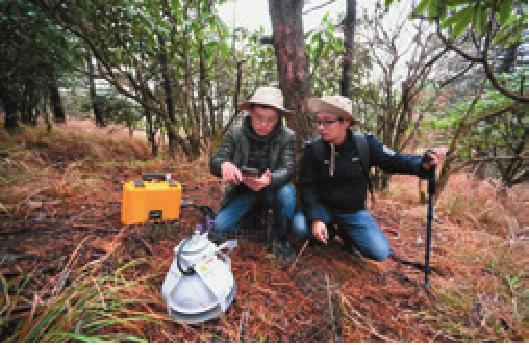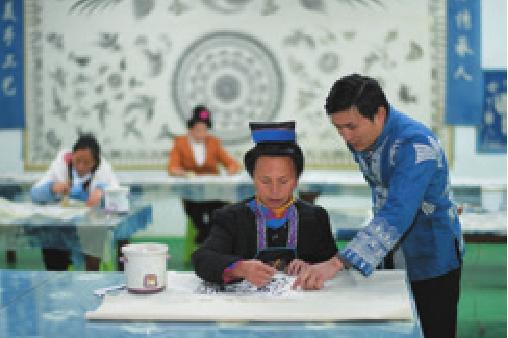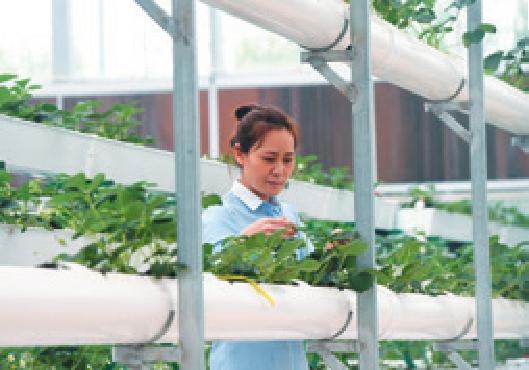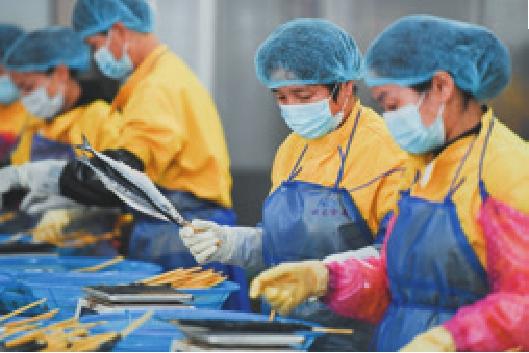HISTORIC PROGRESS

The Change-5 spacecraft gathers rock samples on Moon on December 2. The China National Space Administration announced a day later that the probe has completed the task of taking samples.
Launched on November 24, Change-5 landed on the near side of Moon a week later, tasked to collect Chinas first samples from an extraterrestrial body.
Ascender of Change-5 took off from the lunar surface on December 3, and is expected to complete unmanned rendezvous and docking with the orbiter-returner in lunar orbit.
Game Changer
Students of a primary school in Tangshan, a city in Hebei Province in north China, play floorball on December 2.Public Opinion
An online initiative was launched on December 1 to solicit public feedback on government work, the seventh year in succession such an initiative has been rolled out to improve public policies.The initiative will run through to the annual sessions of the national legislature and the national political advisory body—a key event on the countrys political calendar known as the Two Sessions—in 2021.
Members of the public are invited to weigh in on 22 topics, including macroeconomic management, technological innovation, epidemic prevention and control, employment, entrepreneurship, education, and healthcare.
They can visit a number of websites and platforms to submit their opinions and suggestions. Dubbed A Word to the Premier, the campaign was launched by www.gov.cn in cooperation with other major websites in China.
Organizers say that the best suggestions will guide the group responsible for drafting the Report on the Work of the Government, a flagship document to be delivered during the Two Sessions.
The Two Sessions in 2020 saw nearly 1,400 pieces of advice make it to the drafting group, according to the organizers.
Forest Cover
Yunnan Province in southwest China saw its forest cover reach 23.9 million hectares, increasing from 55.7 percent in 2015 to 62.4 percent in 2020, thanks to afforestation and ecological restoration efforts, local authorities said on December 1.The increase can be attributed to a spate of government-led ecological projects such as turning farmland back into forests and grassland and restoring desertified land, according to Wang Weibin, Deputy Director of the Yunnan Forestry and Grassland Bureau.
The past five years also saw Yunnans forest stock expand from 1.77 billion cubic meters to 2.02 billion cubic meters. About 2.5 million hectares of trees were planted over the period.
The provinces forest area ranks second among Chinas provinciallevel regions.
More Graduates
The number of graduates from Chinese colleges and universities is expected to hit 9.09 million in 2021, an increase of 350,000 over 2020, the Ministry of Education said on December 1 at a video conference held jointly with the Ministry of Human Resources and Social Security.The meeting stressed the importance of supporting graduates to find jobs and start businesses in emerging industries and modern services.
State-owned enterprises as well as medium, small, and micro businesses are encouraged to create more positions for them.
The meeting also called on the graduates to serve in communities and the armed forces.
Ecological Tasks
Poverty alleviation has been coordinated with ecological protection under ecological poverty-relief programs. All such programs have been completed, and over 20 million people shook off poverty through these programs, Li Chunliang, Deputy Director of the National Forestry and Grassland Administration, said at a press conference on December 2.The programs include ecological compensation and governmentsponsored afforestation projects. As a part of the ecological compensation mechanism, forestry authorities nationwide have recruited about 1.1 million forest rangers from impoverished households since 2016. The project offers stable employment while contributing to ecological protection.
Reservoir Overhaul
In the next five years, about 100 billion yuan ($15.2 billion) will be invested to reinforce dilapidated reservoirs, the Ministry of Water Resources said on November 30.Private investment will be mobilized along with central and local fiscal funds to renovate reservoirs, especially small reservoirs that were damaged by severe floods this year, Ye Jianchun, Vice Minister of Water Resources, told a press conference.
China has some 98,000 reservoirs, mostly built in the 1950s to 1970s, with the vast majority being small.
In recent years, about 155.3 billion yuan ($23.7 billion) was allocated to reinforce 2,800 large and medium-sized reservoirs and more than 69,000 small ones.
National Park Research
Sun Jun (left), a doctoral candidate of Fujian Normal University, and a staff member of the Wuyishan National Park in Jiangxi Province in east China, measure soil carbon flux in the Wuyishan area, Fujian Province in southeast China, on December 1. Infrared cameras were installed at the reserve that day for ecological monitoring.Panda Breeding
Shaanxi Province in northwest China has bred 32 captive giant pandas over the last five years, making the province one of the major breeding bases for the animal, local authorities said on December 1.The fourth national survey of giant pandas conducted between 2011 and 2014 showed that Shaanxis wild population of the species reached 345, ranking first in terms of increase and density in the country, Dang Shuangren, Director of the Shaanxi Forestry and Grassland Bureau, said.
The number of captive giant pandas in the world stood at about 600 in November 2019. Fewer than 2,000 pandas live in the wild, mostly in Sichuan and Shaanxi.
Medicine Park
An industrial park processing herbal medicines imported from Russia had been put into operation in Heilongjiang Province in northeast China, Xinhua News Agency reported on November 30.The industrial park in the Suifenhe sub-area of the Heilongjiang Pilot Free Trade Zone(FTZ) has seen six herbal medicineprocessing companies register, according to local authorities.
The 339-million-yuan ($51.46 million) park will have an annual medicine processing capacity of 165,000 tons.
A new policy allows medicinal herbs from Russia, such as ginseng and licorice, to be processed in the Suifenhe area of the FTZ.
Imported drugs can be unloaded, primarily processed and sold directly in Suifenhe, thus helping companies reduce costs, Wang Tengli, general manager of a local pharmaceutical trading company, said.
The Heilongjiang FTZ, inaugurated in August 2019, has three sub-areas, one in provincial capital Harbin and the other two in the cities of Heihe and Suifenhe on the ChinaRussia border.
Since it began operation, the FTZ has taken a series of measures to attract enterprises. They include promoting online services to attract companies, improving its business environment, and cutting costs for foreign trade enterprises.
Keeping Tradition Alive
Wang Fangzhou teaches batik painting in his workshop in Danzhai, a county in Guizhou Province in southwest China, on December 1. Wang, once a migrant worker, returned to his hometown and set up the workshop in 2016.Tomb Relics
Over 1,000 artifacts have been unearthed at a tomb site in Qinghai Province in northwest China, indicating the province used to be a pivotal hub on the ancient Silk Road, archaeologists said, Xinhua reported on December 1.The finds in the Xuewei No.1 Tomb, part of the Reshui Tombs in Dulan County, include silverware, glass and textiles.
The craftsmanship and design of some of the delicate artifacts unearthed have Central and West Asian ethnic features, Han Jianhua, an associate researcher with the Institute of Archaeology under the Chinese Academy of Social Sciences, said.
The multi-chamber tomb is a wood and rock structure consisting of a ground level and an underground level. A long sacrificial pit was found in the tomb, where horses, cows, antelopes and yaks were buried.
“The Xuewei No.1 Tomb is the most structurally intact tomb ever unearthed on the Qinghai-Tibet Plateau,” Han said, adding that it is of great value for the study of burial customs in the area, the relationship between the Tang Dynasty(618-907) and ethnic minorities, the history of Silk Road transportation, and goods and cultural exchanges at that time.
Discovered in 1982, the Reshui Tombs date back to between the 6th and 8th centuries, and are located on both sides of the Qagan Us River at an altitude of 3,400 to 3,500 meters.
Tariff-Free Hainan
Weather radar transceivers worth more than 3.8 million yuan($579,100) became the first batch of tariff-free raw and auxiliary materials to enter the newly established Hainan Free Trade Port (FTP) located on Hainan Island in south China. The transceivers were imported for use by Hainan Airlines and arrived at the Hainan FTP on December 1. According to authorities, the transceivers were exempt from 530,200 yuan ($80,847) of tariffs.The Ministry of Finance (MOF) announced in November that China would waive tariffs on imported raw and auxiliary materials in the Hainan FTP. A circular jointly issued by MOF, the General Administration of Customs of China (GACC) and the State Taxation Administration, stated the exemption would begin from December 1.
According to the circular, import tariffs, value-added tax and consumption tax will be waived for raw and auxiliary materials to be processed in Hainan for manufacturing or service enterprises requiring these materials from overseas for self-use or to be processed into products sold in overseas markets.
To enjoy the tariff exemption, the materials may not be sold within Hainan or moved outside the island.
Initially, the scheme will cover 169 types of raw and auxiliary materials, including farm produce, materials related to energy production, chemical products and spare parts for aircraft and shipping. However, the list is expected to be revised according to the future needs of the islands industries.
Chinese authorities released their plan for the operation of the Hainan FTP on June 1, aiming to build Hainan, which is both an island and a province of China, into a globally influential FTP by the middle of the century.
Building a Link
A cross-sea bridge on the Fuzhou-Xiamen railway is under construction on December 2. With a design speed of 350 km per hour, the high-speed rail connecting the two major cities of Fujian Province in southeast China is expected to open to traffic in 2022.QDII Quotas
Chinas State Administration of Foreign Exchange (SAFE) issued a new round of quotas under the Qualified Domestic Institutional Investor (QDII) scheme on November 30. The scheme is an important channel for domestic investors to invest in securities outside of their home country.The new QDII quotas, valued at$4.296 billion, were granted to each of 23 financial institutions, including fund companies, securities firms, banks, wealth management subsidiaries of banks, and trust companies, according to SAFE.
The move echoed previous efforts by SAFE to normalize the issuance of QDII quotas. The administration had previously issued three rounds of quotas under the QDII scheme since September, granting a total of approximately $12.72 billion worth of quotas to 71 institutions. According to official data, this latest issuance brings the total to roughly$116.7 billion, distributed among 169 institutions under the QDII scheme.
The scheme allows domestic investors to purchase foreign assets. According to market analysts, the cross-border flow of capital has remained stable under the scheme in recent years. Analysts added that the impact of QDII quota issuance on Chinas domestic capital market, cross-border capital flows, and the renminbi exchange rate is generally under control.
SAFE cautioned QDII institutions to carry out outbound investment in a prudent and orderly manner, to improve product diversity, and manage and control the risks of investing in foreign markets.
Outbound Investment
China will expand the scale of two pilot schemes that allow domestic investors to access foreign assets, SAFE announced on November 29.According to SAFE, the scale of the two outbound investment schemes, known as the Qualified Domestic Limited Partner (QDLP) and the Qualified Domestic Investment Enterprise (QDIE), in Shanghai, Beijing and Shenzhen will be expanded in the near future. The move aims to further meet domestic investors demands for global asset allocation.
The government also plans to launch a pilot QDLP program in Hainan, and in Chongqing Municipality in southwest China to better support the development of the Hainan FTP and the ChengduChongqing Economic Circle, according to the administration.
Green Opportunity
A staff member checks vegetables in a smart greenhouse at a modern agriculture demonstration park in Hejian, Hebei Province in north China, on November 29. The local government encourages farmers to develop modern agricultural practices to increase their income.Internet Plus Tourism
Chinese authorities have issued new guidelines to make domestic tourist destinations more intelligent. The guidelines, which lay out a plan for what is known as Internet Plus Tourism, were announced on November 30.Jointly released by 10 departments including the Ministry of Culture and Tourism and the National Development and Reform Commission, the guidelines say that by 2025, tourist attractions rated 4A or above are to be upgraded to provide smarter services.
The guidelines call on tourist attractions and resorts to expand 5G network coverage and speed up the application of unmanned, non-contact facilities. They also encourage tourist destinations to make use of advanced technologies such as big data and cloud computing to provide detailed traffic, weather and other tourist information in a timely manner.
According to the guidelines, China aims to revive tourism to preCOVID-19 levels by 2022.
Super Factory
Tesla China announced on November 27 that it plans to build a supercharger manufacturing facility in Shanghai. Owned by U.S. electric car manufacturer Tesla, the new factory is expected to begin operation in the first quarter of 2021.With a planned investment of 42 million yuan ($6.4 million), the plant will produce 10,000 superchargers annually, mainly the V3 model, at the initial stage. The company claimed a V3 supercharger can add up to 250 km of range to a Tesla vehicle after charging for 15 minutes.
Currently, Tesla superchargers used in China are all imported from the U.S. Tesla established 30 supercharging stations in October, covering 18 Chinese cities. It is estimated that the company will have nearly 650 supercharging stations with more than 5,000 chargers in total in China by the end of this year.
Import Ban
China will ban all imports of solid waste from January 1, 2021. According to a notice released by the Ministry of Ecology and Environment, the Ministry of Commerce and GACC on November 27, the dumping, stacking and disposal of waste products from overseas on Chinese territory will also be banned.The total ban is the culmination of policies introduced since 2017 to phase out solid waste import. In late 2017, China banned the import of 24 types of solid waste, including unsorted paper, textiles and vanadium slag.
China began importing solid waste as a source of raw materials in the 1980s and, despite its limited waste disposal capacity, had been the worlds largest importer for years. During that time, some companies also illegally imported foreign waste for profit, posing a threat to the environment and public health.
With growing public awareness of environmental issues and the success of Chinas green development drive, its solid waste imports have decreased significantly. Last year, the imports stood at 13.48 million tons, down from 22.63 million tons in 2018. In the first 10 months of this year, solid waste imports plunged 42.7 percent year on year.

